“If the most popular foods of Rio de Janeiro have one thing in common, it is their informality. While you can find fine restaurants in Rio, what sets the city apart and brings its residents, known as “Cariocas”, together is the unpretentious food they eat in crowded bars and on busy street corners after a day at the beach. They are foods best served with lots of friends, non-stop conversation, glass after glass of cold, draft beer known as “chopp”, and if you are lucky, local music. No sun-drenched Saturday in Rio is complete without lunching on a plate of dried meats and sausages stewed with black beans and served with rice, shredded collard greens, slices of orange and farofa – manioc flour mixed with eggs or banana. This meal, that many trace back to the food given slaves on sugar and coffee plantations, can be found throughout the city, but many consider Bar do Mineiro (Rua Paschoal Carlos Magno, 99 – Santa Teresa) to be among the best. Located in the bohemian Santa Teresa neighborhood on a hill overlooking Rio's downtown, they serve a wide variety of cachaças, a clear sugar-cane liquor that forms the basis of the caipirinha, Brazil's fruity national drink. Brazilian barbecue has gone global and you can find expensive versions in Asia, Europe and North America.
But if you want to eat at a more humble version that takes you back to a less ostentatious age where the all-you-can-eat “Rodizio” grill began, try Churrascaria Palace (Rua Rodolfo Dantas, 16 – Copacabana) a half block from Copacabana beach and across the street from the Copacabana Palace, the city's most storied hotel. The waiters will keep the food coming until you say “stop!” Popular cuts include picanha (top sirloin cap), alcatra (sirloin) and fraldinha (flank steak), while the long-grilled beef ribs are a house specialty, served with panache. But if you aren't in the mood for a meat overdose, you might try one of the many non-rodizio churrascarias in the city. One of the most popular is the always full Brazeiro da Gávea (Praça Santos Dumont, 116 – Gávea). The house favorite is its grilled linguça, or sausages, brought around on demand. Its the perfect way to open an evening of drinking along the bustling streets and restaurants of one of Rio's most popular nighttime neighborhoods, Baixo Gávea. Of the myriad carioca street foods, one of the most popular is the pastel, a large deep-fried dumpling filled with cheese, meat, chicken, shrimp and other delights. They are easiest to find at the weekly farmers markets where locals buy produce. With a glass of fresh-squeezed sugar-cane juice (caldo de cana) or a coconut water (agua de coco), a pastel is the perfect thing to hold off hunger as you lug your vegetables home from the street market to cook lunch or after a walk on the beach.
Podrões are the “filthy” street sandwich stands, many of which ring the edges of the busiest night life districts. Not all of them are dirty. They serve up cheap hamburgers, hotdogs and other sandwiches on a griddle with all the trimmings, just the thing you need after a night of partying. One of the best famous is Sanduicheria Rio Joana (Corner of Rua Otacílio Negrão de Lima and Rua Gonzaga Bastos – Vila Isabel). Churrascaria de Rua, or street grill: Sometimes called “cat grills” (churrascaria de gato) because of an urban legend that said they roasted cats, they remain a local favorite offering your basic beef, chicken and sometimes vegetables on a stick roasted over coals. Among the most loved can be found in Tijuca at the corners of Rua Uruguai and Rua Barao de Mesquita near the Uruguai Metro stop. In addition to meat they usually offer sausages, and sometimes a tasty roasted rubbery cheese known as queijo coalho. Don't forget to roll your meat in some toasted manioc flour to keep the fat from dripping on your shirt and to add a nice extra Brazilian taste.
Bolinho de Bacalhão, or “codfish croquettes” are perhaps the most famous Rio de Janeiro bar food. But a really sublime bolhinho, with the right mix of salt-cod, flour, potatoes and spice fried in the right oil, is hard to find. Perhaps the best can be found at Cantinho das Concertinas (Rua Capitao Félix, 110 – Benfica), or "Accordion Corner" at Rio de Janeiro's central CADEG vegetable and flower market. Cantinho das Concertinas is one of the central meeting places of Rio's large Portuguese community. On weekend afternoons, Portuguese music brings in a large, happy crowd to the busy market. There is dancing and singing and lots of happy eating and drinking.
Pão de Queijo, or Brazilian cheese bread, comes from the neighboring highland state of Minas Gerais but perhaps the best pão de queijo of all time can be found in Cultivar (Rua Paschoal Carlos Magno, 124 – Santa Teresa) in Santa Teresa. Sardinha Frita, or batter-fried sardines are a staple of the city's central port district. The large Brazilian sardines are gutted, and butterfly split into a flat mat, battered, deep fried and served in stacks of ten with the tails on. The best place for sardinha frita is Beco das Sardinhas or “Sardine Alley”. Of the sardine fry shops there, the most famous is O Rei dos Frangos Marítimos (Rua Miguel Couto, 139 A – Centro) or “The King of Sea Chickens”. Only two blocks from the new museums, revitalized docks, cruise ships and Olympic cultural activities on the recently renovated Praça Mauá, the area and its most famous snack are regaining popularity after years of neglect”. – Thales Carneiro, Jeb Blount, Sergio Moraes and Sebastian Rocandio via Reuters
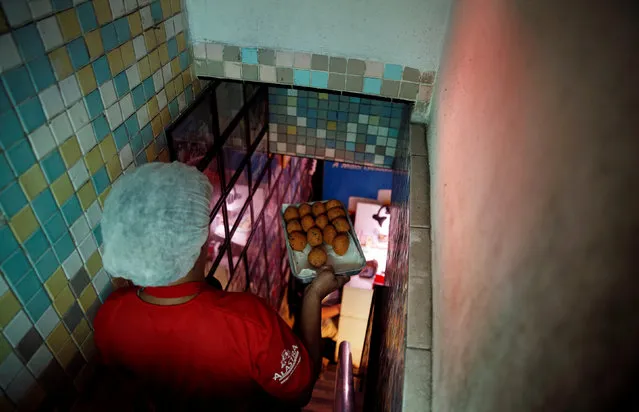
A woman carries traditional bolinhos de bacalhau (fried codfish balls) in Rio de Janeiro, Brazil, May 7, 2016. (Photo by Sergio Moraes/Reuters)
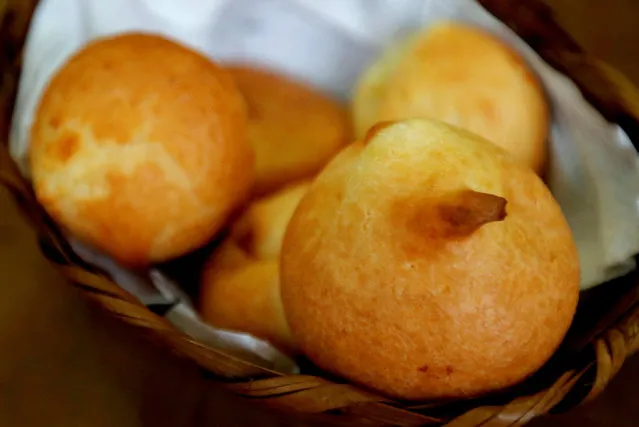
Paes de queijo (cheese bread) lies in a basket at the Cultivar cafe and store at Santa Teresa neighbourhood in Rio de Janeiro, Brazil, July 28, 2016. (Photo by Sergio Moraes/Reuters)
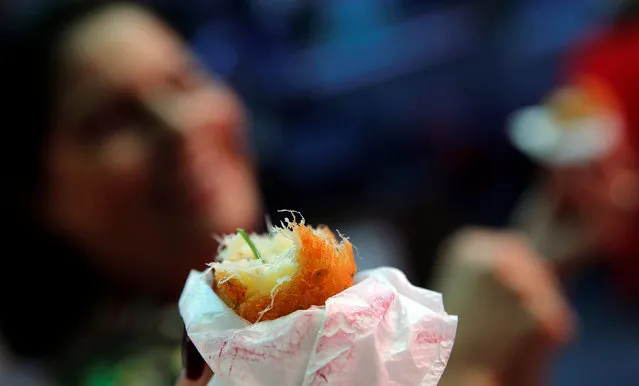
A view of traditional bolinhos de bacalhau (fried codfish balls) in Rio de Janeiro, Brazil, May 7, 2016. (Photo by Sergio Moraes/Reuters)
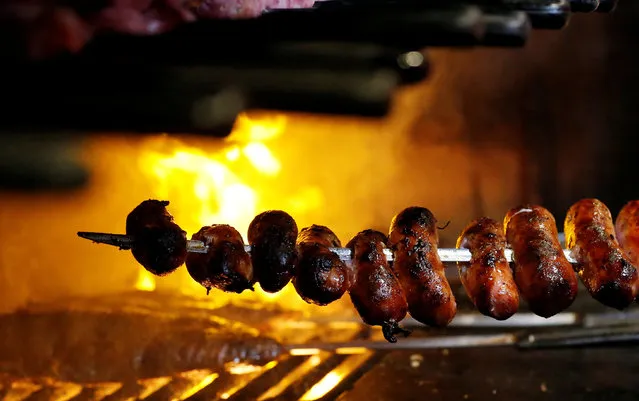
An employee grills sausages at the Braseiro restaurant in Rio de Janeiro, Brazil, July 28, 2016. (Photo by Sergio Moraes/Reuters)
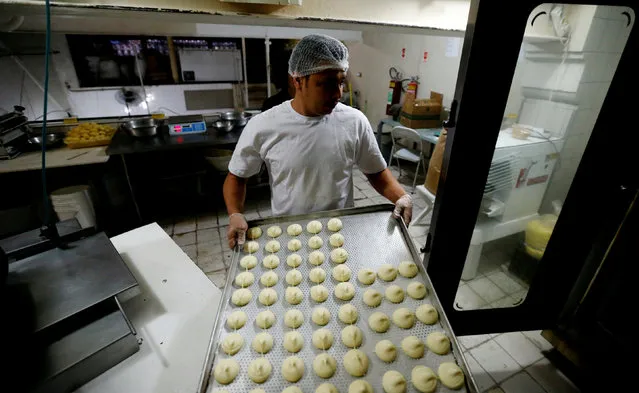
A worker prepares pao de queijo (cheese bread) at the Cultivar cafe and store in Santa Teresa neighbourhood in Rio de Janeiro, Brazil, July 28, 2016. (Photo by Sergio Moraes/Reuters)
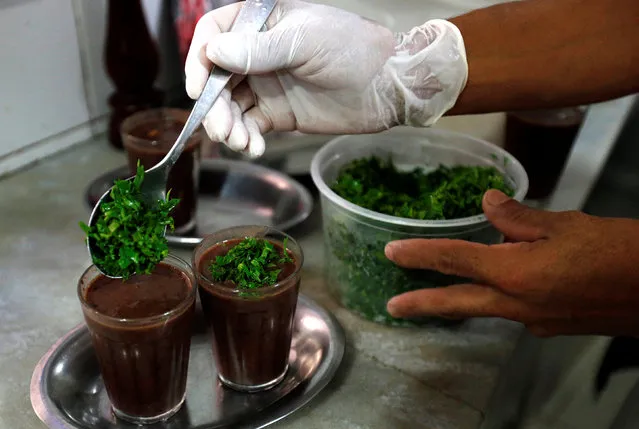
A man prepares a soup of beans as part of the Brazilian traditional dish called feijoada at the Bar do Mineiro in Rio de Janeiro, Brazil, March 24, 2016. (Photo by Sergio Moraes/Reuters)
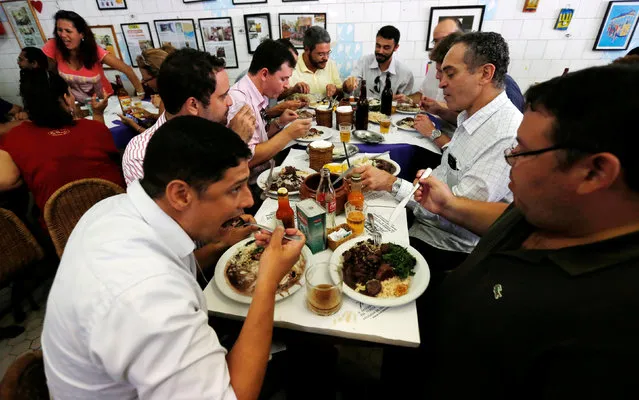
People enjoy the Brazilian traditional dish called feijoada (black bean and meat stew) at the Bar do Mineiro in Rio de Janeiro, Brazil, March 24, 2016. (Photo by Sergio Moraes/Reuters)
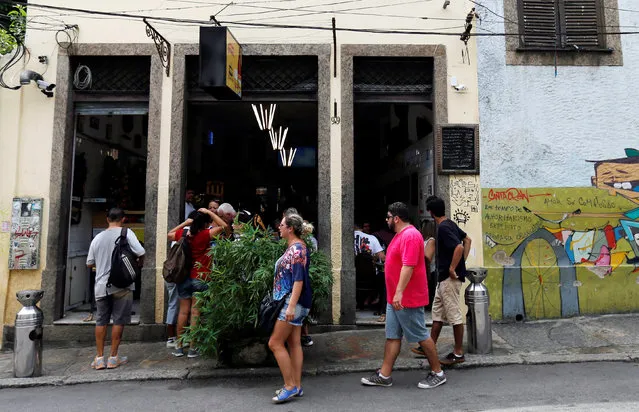
People arrive to eat the Brazilian traditional dish feijoada (black bean and meat stew) at the Bar do Mineiro in Rio de Janeiro, Brazil, March 24, 2016. (Photo by Sergio Moraes/Reuters)
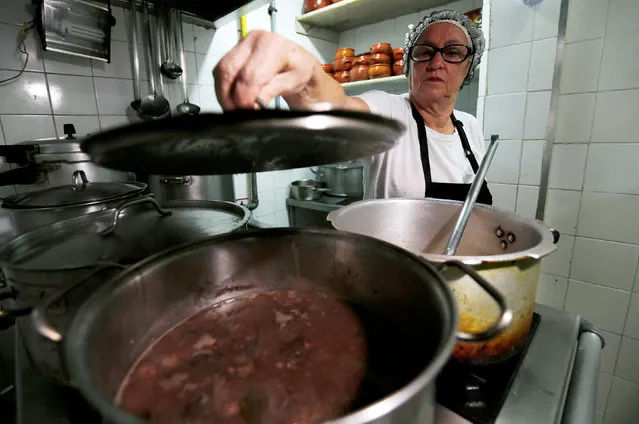
A cook prepares the Brazilian traditional dish called feijoada (black bean and meat stew) at the Bar do Mineiro in Rio de Janeiro, Brazil, March 24, 2016. (Photo by Sergio Moraes/Reuters)
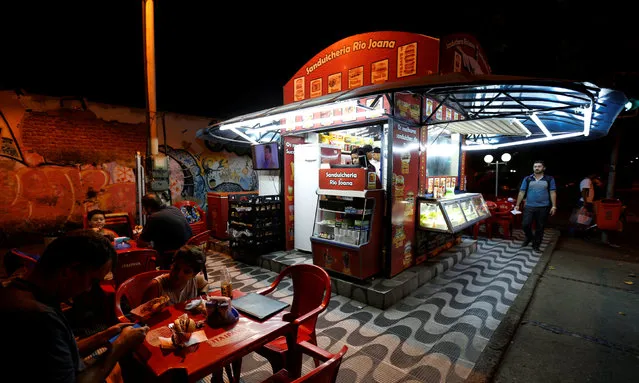
A view of a kiosk selling podrao, the Portuguese word for “rotten” (a hotdog or burger type sandwich assembled according to taste), is seen in Rio de Janeiro, Brazil, April 8, 2016. (Photo by Sergio Moraes/Reuters)
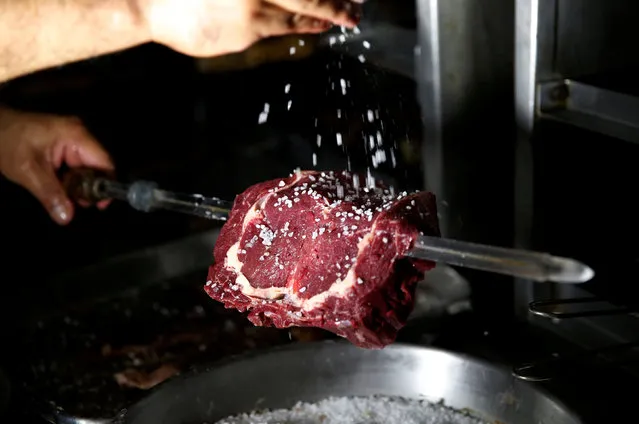
A man prepares meat for churrasco rodizio (the Brazilian spit rotisserie) in Rio de Janeiro, Brazil, May 27, 2016. (Photo by Sergio Moraes/Reuters)
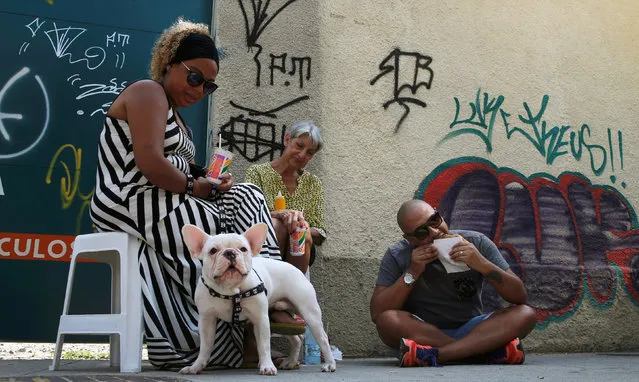
People eat street market-purchased food and drinks including pasteis de feira (pastries) in Rio de Janeiro, Brazil, May 7, 2016. (Photo by Sergio Moraes/Reuters)
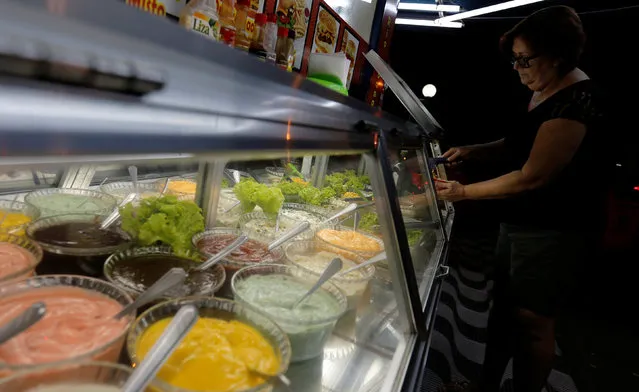
A woman choses the elements of her podrao, the Portuguese word for “rotten” (a hotdog or burger type sandwich assembled according to taste), in Rio de Janeiro, Brazil, April 8, 2016. (Photo by Sergio Moraes/Reuters)
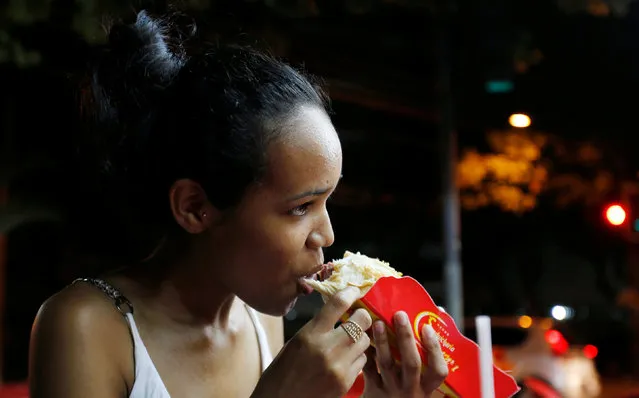
A woman eats a podrao, the Portuguese word for “rotten” (a hotdog or burger type sandwich assembled according to taste), in Rio de Janeiro, Brazil, April 8, 2016.. (Photo by Sergio Moraes/Reuters)
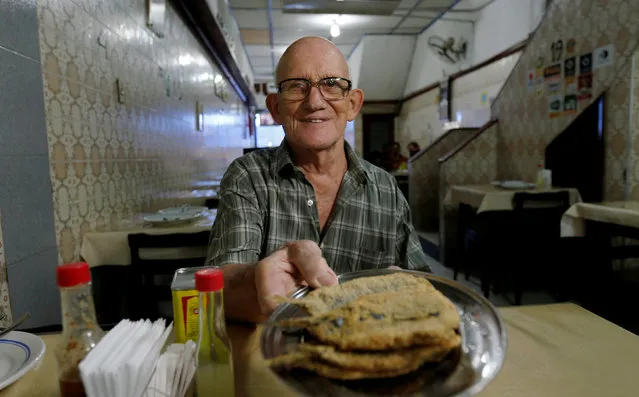
The chef shows fried sardines at the Beco das Sardinha in Rio de Janeiro, Brazil, April 12, 2016. (Photo by Sergio Moraes/Reuters)
But if you want to eat at a more humble version that takes you back to a less ostentatious age where the all-you-can-eat “Rodizio” grill began, try Churrascaria Palace (Rua Rodolfo Dantas, 16 – Copacabana) a half block from Copacabana beach and across the street from the Copacabana Palace, the city's most storied hotel. The waiters will keep the food coming until you say “stop!” Popular cuts include picanha (top sirloin cap), alcatra (sirloin) and fraldinha (flank steak), while the long-grilled beef ribs are a house specialty, served with panache. But if you aren't in the mood for a meat overdose, you might try one of the many non-rodizio churrascarias in the city. One of the most popular is the always full Brazeiro da Gávea (Praça Santos Dumont, 116 – Gávea). The house favorite is its grilled linguça, or sausages, brought around on demand. Its the perfect way to open an evening of drinking along the bustling streets and restaurants of one of Rio's most popular nighttime neighborhoods, Baixo Gávea. Of the myriad carioca street foods, one of the most popular is the pastel, a large deep-fried dumpling filled with cheese, meat, chicken, shrimp and other delights. They are easiest to find at the weekly farmers markets where locals buy produce. With a glass of fresh-squeezed sugar-cane juice (caldo de cana) or a coconut water (agua de coco), a pastel is the perfect thing to hold off hunger as you lug your vegetables home from the street market to cook lunch or after a walk on the beach.
Podrões are the “filthy” street sandwich stands, many of which ring the edges of the busiest night life districts. Not all of them are dirty. They serve up cheap hamburgers, hotdogs and other sandwiches on a griddle with all the trimmings, just the thing you need after a night of partying. One of the best famous is Sanduicheria Rio Joana (Corner of Rua Otacílio Negrão de Lima and Rua Gonzaga Bastos – Vila Isabel). Churrascaria de Rua, or street grill: Sometimes called “cat grills” (churrascaria de gato) because of an urban legend that said they roasted cats, they remain a local favorite offering your basic beef, chicken and sometimes vegetables on a stick roasted over coals. Among the most loved can be found in Tijuca at the corners of Rua Uruguai and Rua Barao de Mesquita near the Uruguai Metro stop. In addition to meat they usually offer sausages, and sometimes a tasty roasted rubbery cheese known as queijo coalho. Don't forget to roll your meat in some toasted manioc flour to keep the fat from dripping on your shirt and to add a nice extra Brazilian taste.
Bolinho de Bacalhão, or “codfish croquettes” are perhaps the most famous Rio de Janeiro bar food. But a really sublime bolhinho, with the right mix of salt-cod, flour, potatoes and spice fried in the right oil, is hard to find. Perhaps the best can be found at Cantinho das Concertinas (Rua Capitao Félix, 110 – Benfica), or "Accordion Corner" at Rio de Janeiro's central CADEG vegetable and flower market. Cantinho das Concertinas is one of the central meeting places of Rio's large Portuguese community. On weekend afternoons, Portuguese music brings in a large, happy crowd to the busy market. There is dancing and singing and lots of happy eating and drinking.
Pão de Queijo, or Brazilian cheese bread, comes from the neighboring highland state of Minas Gerais but perhaps the best pão de queijo of all time can be found in Cultivar (Rua Paschoal Carlos Magno, 124 – Santa Teresa) in Santa Teresa. Sardinha Frita, or batter-fried sardines are a staple of the city's central port district. The large Brazilian sardines are gutted, and butterfly split into a flat mat, battered, deep fried and served in stacks of ten with the tails on. The best place for sardinha frita is Beco das Sardinhas or “Sardine Alley”. Of the sardine fry shops there, the most famous is O Rei dos Frangos Marítimos (Rua Miguel Couto, 139 A – Centro) or “The King of Sea Chickens”. Only two blocks from the new museums, revitalized docks, cruise ships and Olympic cultural activities on the recently renovated Praça Mauá, the area and its most famous snack are regaining popularity after years of neglect”. – Thales Carneiro, Jeb Blount, Sergio Moraes and Sebastian Rocandio via Reuters

A woman carries traditional bolinhos de bacalhau (fried codfish balls) in Rio de Janeiro, Brazil, May 7, 2016. (Photo by Sergio Moraes/Reuters)

Paes de queijo (cheese bread) lies in a basket at the Cultivar cafe and store at Santa Teresa neighbourhood in Rio de Janeiro, Brazil, July 28, 2016. (Photo by Sergio Moraes/Reuters)

A view of traditional bolinhos de bacalhau (fried codfish balls) in Rio de Janeiro, Brazil, May 7, 2016. (Photo by Sergio Moraes/Reuters)

An employee grills sausages at the Braseiro restaurant in Rio de Janeiro, Brazil, July 28, 2016. (Photo by Sergio Moraes/Reuters)

A worker prepares pao de queijo (cheese bread) at the Cultivar cafe and store in Santa Teresa neighbourhood in Rio de Janeiro, Brazil, July 28, 2016. (Photo by Sergio Moraes/Reuters)

A man prepares a soup of beans as part of the Brazilian traditional dish called feijoada at the Bar do Mineiro in Rio de Janeiro, Brazil, March 24, 2016. (Photo by Sergio Moraes/Reuters)

People enjoy the Brazilian traditional dish called feijoada (black bean and meat stew) at the Bar do Mineiro in Rio de Janeiro, Brazil, March 24, 2016. (Photo by Sergio Moraes/Reuters)

People arrive to eat the Brazilian traditional dish feijoada (black bean and meat stew) at the Bar do Mineiro in Rio de Janeiro, Brazil, March 24, 2016. (Photo by Sergio Moraes/Reuters)

A cook prepares the Brazilian traditional dish called feijoada (black bean and meat stew) at the Bar do Mineiro in Rio de Janeiro, Brazil, March 24, 2016. (Photo by Sergio Moraes/Reuters)

A view of a kiosk selling podrao, the Portuguese word for “rotten” (a hotdog or burger type sandwich assembled according to taste), is seen in Rio de Janeiro, Brazil, April 8, 2016. (Photo by Sergio Moraes/Reuters)

A man prepares meat for churrasco rodizio (the Brazilian spit rotisserie) in Rio de Janeiro, Brazil, May 27, 2016. (Photo by Sergio Moraes/Reuters)

People eat street market-purchased food and drinks including pasteis de feira (pastries) in Rio de Janeiro, Brazil, May 7, 2016. (Photo by Sergio Moraes/Reuters)

A woman choses the elements of her podrao, the Portuguese word for “rotten” (a hotdog or burger type sandwich assembled according to taste), in Rio de Janeiro, Brazil, April 8, 2016. (Photo by Sergio Moraes/Reuters)

A woman eats a podrao, the Portuguese word for “rotten” (a hotdog or burger type sandwich assembled according to taste), in Rio de Janeiro, Brazil, April 8, 2016.. (Photo by Sergio Moraes/Reuters)

The chef shows fried sardines at the Beco das Sardinha in Rio de Janeiro, Brazil, April 12, 2016. (Photo by Sergio Moraes/Reuters)
05 Aug 2016 13:20:00,
post received
0 comments
